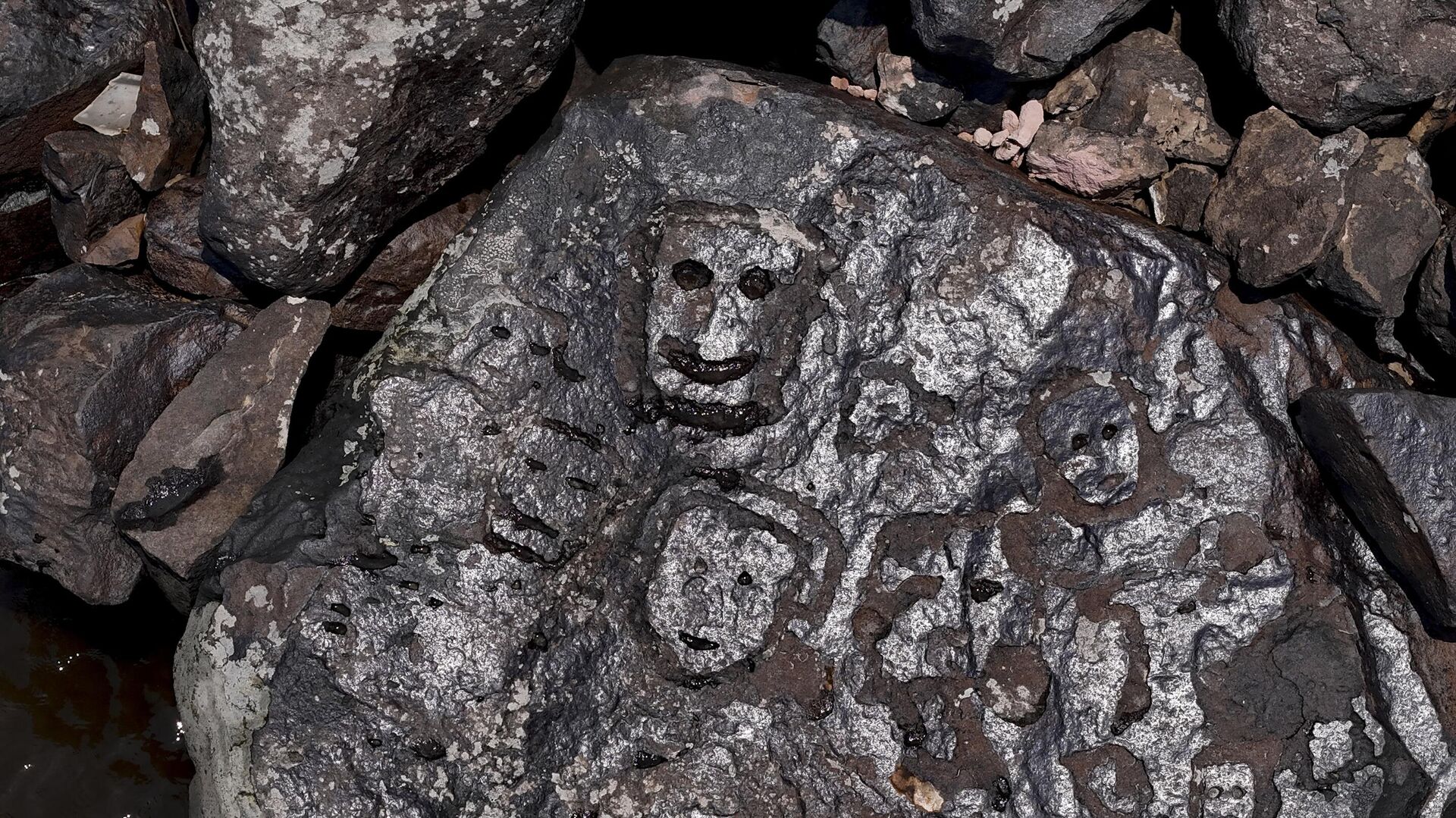https://sputnikglobe.com/20231027/ancient-rock-carvings-emerge-in-brazil-as-amazon-waters-hit-record-low-amid-drought-1114514801.html
Ancient Rock Carvings Emerge in Brazil as Amazon Waters Hit Record Low Amid Drought
Ancient Rock Carvings Emerge in Brazil as Amazon Waters Hit Record Low Amid Drought
Sputnik International
The low water levels of the Rio Negro have exposed enigmatic carvings, including human faces, animals, and natural forms, at the archaeological site known as the Ponto das Lajes, or Place of Slabs.
2023-10-27T01:16+0000
2023-10-27T01:16+0000
2023-10-27T01:16+0000
beyond politics
science & tech
amazon
brazil
archeology
archaeology
archaeology
https://cdn1.img.sputnikglobe.com/img/07e7/0a/1b/1114514644_0:0:2866:1612_1920x0_80_0_0_e18ca43193fb5b044a2ac24273c1e8c5.jpg
Petroglyphs, some of which date back 2,000 years, have resurfaced along the Amazon riverbanks in Brazil at an archaeological site known as the Ponto as Lajes, or Place of Slabs, due to an unprecedented drought.The historic dry spell is believed to be linked to the El Niño weather pattern and the ongoing climate crisis. Water levels at the Rio Negro have managed to fall to never-before-seen levels, at a depth of 12.89 meters.Carlos Augusto da Silva, an archaeologist from the Federal University of Amazonas, has identified 25 groups of carvings, which were located on a single rock. The official believes the rock acted as a whetstone for sharpening various instruments.Fragments of pottery believed to be thousands of years old have also reportedly been found at the site, where large Indigenous villages were located in pre-Columbian times.Remarkably, despite its archaeological importance, the Ponto das Lajes petroglyphs have never been thoroughly studied. Researchers are estimating their age based on similar rock carvings found in other parts of central Amazonia.Archaeologist Filippo Stampanoni Bassi emphasized the significance of preserving these historical sites, stating they "tell the region’s ancient Indigenous history and must be treated with respect by all of us who live in Manaus today."
https://sputnikglobe.com/20231024/tattoo-referencing-christ-unearthed-in-sudan-on-1300-year-old-excavated-body-1114439297.html
amazon
brazil
Sputnik International
feedback@sputniknews.com
+74956456601
MIA „Rossiya Segodnya“
2023
News
en_EN
Sputnik International
feedback@sputniknews.com
+74956456601
MIA „Rossiya Segodnya“
Sputnik International
feedback@sputniknews.com
+74956456601
MIA „Rossiya Segodnya“
drought in brazil, amazon drought, amazon carvings, rio negro, ponto das lajes, place of slabs, ancient carvings in brazil, brazilian archeology
drought in brazil, amazon drought, amazon carvings, rio negro, ponto das lajes, place of slabs, ancient carvings in brazil, brazilian archeology
Ancient Rock Carvings Emerge in Brazil as Amazon Waters Hit Record Low Amid Drought
The intricate carvings along the Amazonian riverbanks were earlier uncovered in 2010 during a severe drought. At the time, water levels of the Rio Negro plummeted to over 13 meters.
Petroglyphs, some of which date back 2,000 years, have resurfaced along the Amazon riverbanks in Brazil at an archaeological site known as the Ponto as Lajes, or Place of Slabs, due to an unprecedented drought.
The historic dry spell is believed to be linked to the El Niño weather pattern and the ongoing climate crisis. Water levels at the Rio Negro have managed to fall to never-before-seen levels, at a depth of 12.89 meters.
The petroglyphs are estimated to be between 1,000 and 2,000 years old, shedding light on the region's ancient Indigenous history. Some of the rocks also bear grooves that suggest the site was used for producing stone tools, highlighting its significance as an area for tool preparation.
Carlos Augusto da Silva, an archaeologist from the Federal University of Amazonas, has identified 25 groups of carvings, which were located on a single rock. The official believes the rock acted as a whetstone for sharpening various instruments.
Fragments of pottery believed to be thousands of years old have also reportedly been found at the site, where large Indigenous villages were located in pre-Columbian times.

24 October 2023, 00:50 GMT
Remarkably, despite its archaeological importance, the Ponto das Lajes petroglyphs have never been thoroughly studied. Researchers are estimating their age based on similar rock carvings found in other parts of central Amazonia.
Archaeologist Filippo Stampanoni Bassi emphasized the significance of preserving these historical sites, stating they "tell the region’s ancient Indigenous history and must be treated with respect by all of us who live in Manaus today."



